
The Rutan Model 202 Boomerang is an aircraft designed and built by Burt Rutan. The design was intended to be a multi-engine aircraft that in the event of failure of a single engine would not become dangerously difficult to control due to asymmetric thrust. The result is an asymmetrical aircraft with a very distinct appearance.
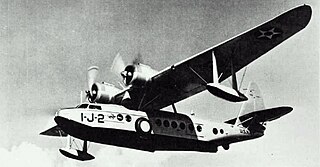
The Sikorsky S-43 was a 1930s American twin-engine amphibious flying boat monoplane produced by Sikorsky Aircraft.

The Starr Bumble Bee II was an experimental aircraft designed and built specifically to acquire the title of “The World’s Smallest Airplane”.
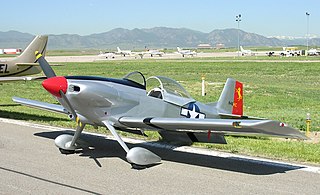
The Van's RV-3 is a single-seat, single-engine, low-wing kit aircraft sold by Van's Aircraft. Unlike many other aircraft in the RV line, the RV-3 is only available as a tail-wheel equipped aircraft, although it is possible that some may have been completed by builders as nose-wheel versions. The RV-3 is the genesis design for the rest of the RV series, all which strongly resemble the RV-3. The RV-4 was originally developed as a two-seat RV-3.

The AS/SA 202 Bravo is a two to three-seat civil light aircraft jointly designed and manufactured by the Swiss company Flug- und Fahrzeugwerke Altenrhein (FFA) and the Italian company Savoia-Marchetti. The aircraft was designated the AS 202 in Switzerland, and the SA 202 in Italy.
The Fisher FP-606 Sky Baby is a Canadian single-seat, conventional landing gear or tricycle landing gear-equipped, single-engined, high-wing monoplane kit aircraft designed for construction by amateur builders. Fisher Flying Products was originally based in Edgeley, North Dakota, USA but the company is now located in Woodbridge, Ontario, Canada.
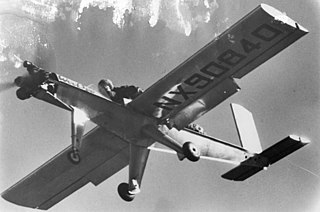
The Beecraft Wee Bee was an American ultralight monoplane designed and built by Beecraft. It was described as the world's smallest plane. Later the Starr Bumble Bee II would claim that title.

The Stits SA-3A Playboy is a single seat, strut-braced low-wing monoplane that was designed by Ray Stits for amateur construction. The aircraft was designed and the prototype was completed in a three-month period during 1952. The design went on to become one of the most influential in the post-war boom in aircraft homebuilding.

The Horten H.III was a flying wing sailplane built by Walter and Reimar Horten in Germany from 1937 to 1944.
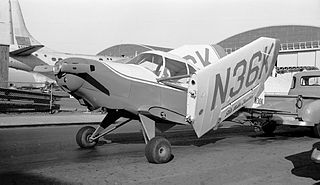
The Stits-Besler Executive is a three place homebuilt aircraft designed by Ray Stits, as the Stits SA-4A Executive.

The Stits SA-7 Skycoupe is a two-seat, side-by-side seating, high wing homebuilt aircraft designed by Ray Stits.

The Spartan C2 is a light aircraft produced in the United States in the early 1930s as a low-cost sport machine that would sell during the Great Depression.
The Stits SA-8A Skeeto is an early homebuilt ultralight design by Ray Stits.
The Staib LB-2, also called the Little Bastard, Little Bit and The Monster, is a homebuilt aircraft design of Wilbur Staib. It once held the title as the "worlds smallest monoplane".
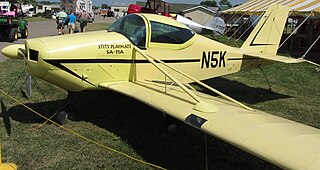
The Stits SA-11A Playmate is a homebuilt aircraft design that features a rapid wing-folding mechanism for trailering or storage.
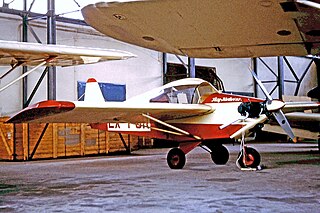
The Stits SA-5 Flut-R-Bug is a homebuilt aircraft designed by Ray Stits.

The RV-1 is a Stits Playboy that was constructed with modifications by Richard VanGrunsven. The aircraft was the first of a series of Van's aircraft that became the most popular homebuilt aircraft produced.

The Van's Aircraft RV-14 is an American aerobatic kit aircraft designed by Richard VanGrunsven and produced by Van's Aircraft. It was introduced at AirVenture in July 2012. The aircraft is supplied as a kit for amateur construction.

The Stits DS-1 Baby Bird is a homebuilt aircraft built to achieve a "world's smallest" status. The Baby Bird is in the Guinness Book of World Records as the “Smallest Airplane in the World.” as of 1984. The title was later defined as "world's smallest monoplane" to acknowledge Robert H. Starr's Bumble Bee II as the world's smallest biplane.
The Duane's Hangar Ultrababy is an American homebuilt aircraft that was designed by Duane Patrick and produced by Duane's Hangar of Liberty, South Carolina, introduced about 1997. When it was available the aircraft was supplied in the form of plans for amateur construction.


















